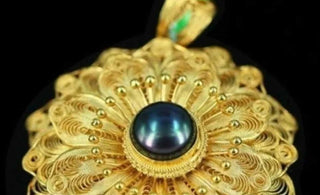
The secret ingredients that make imperial handicrafts uniquely captivating lie in the exquisite materials used, each chosen for its beauty, rarity, and symbolic significance. These materials are not mere physical substances but are imbued with deep cultural and historical meaning, making them the cornerstone of the imperial handicrafts' allure and mystique. In the realm of these ancient arts, every material speaks a thousand words, telling tales of emperors and empires, of ancient wisdom, and of the eternal pursuit of beauty and perfection.In this realm of artistic wonders, Chinese Imperial Handicrafts stand as the epitome of artistic excellence, embodying the rich cultural heritage and timeless elegance of ancient China. These masterpieces, crafted with meticulous attention to detail and infused with the spirit of generations past, owe their uniqueness not only to the skill of the artisans but also to the secret ingredients that make them truly extraordinary.
The Mystique of Porcelain
One of the quintessential materials that lend Chinese Imperial Handicrafts their distinctiveness is porcelain. Revered as the "white gold" of China, porcelain has captivated the world with its delicate translucence, pure whiteness, and remarkable durability. This fine ceramic material, crafted from a blend of kaolin clay and other minerals, undergoes a meticulous process of shaping, firing, and glazing to achieve its exquisite form. Porcelain, with its ethereal beauty and lustrous surface, has been an integral part of Chinese art for centuries. From the elegant curves of a porcelain vase to the intricate patterns adorning porcelain plates, each piece tells a story of skilled craftsmanship and artistic vision. The secret lies in the combination of mineral ingredients and the precise firing techniques, which result in the renowned durability and timeless elegance of Chinese porcelain.
The Allure of Jade
Another material that holds a revered place in Chinese Imperial Handicrafts is jade. Symbolizing purity, immortality, and prosperity, jade has been treasured by emperors, scholars, and connoisseurs throughout history. Prized for its vibrant colors, smooth texture, and inherent spiritual qualities, jade is painstakingly carved and polished to create exquisite ornaments, sculptures, and jewelry. Jade, with its mesmerizing hues ranging from pale green to deep emerald, is believed to possess mystical powers and bring harmony to its wearer. Its presence in Chinese Imperial Handicrafts adds a touch of elegance and prestige to these masterpieces, elevating them to the realm of the extraordinary. The intricate carvings, delicate engravings, and meticulous attention to detail showcase the deep reverence and artistic virtuosity associated with this precious gemstone.Revered in the East as the "stone of heaven," jade stands at the pinnacle of imperial materials. Its smooth texture, translucent quality, and resilience made it a symbol of purity, morality, and immortality. In imperial handicrafts, jade was intricately carved into delicate ornaments, regal scepters, and intricate jewelry, each piece a testament to the stone's enduring appeal and the skilled artisan's craftsmanship.
The Radiance of Silk
No discussion of Chinese Imperial Handicrafts would be complete without mentioning the ethereal beauty of silk. Revered as the "Queen of Fabrics," silk has been synonymous with luxury, refinement, and elegance in Chinese culture for millennia. The intricate weaving techniques, vibrant colors, and silky texture of this exquisite material have made it a favored medium for clothing, tapestries, and other artistic creations. Silk, with its natural sheen and graceful drape, has the ability to captivate the senses and transport one to a world of opulence and splendor. The delicate threads of silk, meticulously spun from the cocoons of silkworms, are transformed into garments fit for emperors, intricately embroidered tapestries, and sumptuous textiles that adorn palaces and temples. Its inclusion in Chinese Imperial Handicrafts adds a layer of sophistication and elegance that is unmatched.More than just a textile, silk was the embodiment of luxury and refinement in imperial China. This soft, lustrous material was the foundation of imperial wardrobe and decor. Silk's versatility allowed it to be dyed in vivid colors and embroidered with intricate designs, featuring dragons, phoenixes, and other auspicious symbols, each stitch a display of unrivaled artistry.
The Mastery of Lacquer
Another secret ingredient that contributes to the uniqueness of Chinese Imperial Handicrafts is the art of lacquer. With its lustrous sheen, rich colors, and remarkable durability, lacquer has been used for centuries to create exquisite furniture, decorative objects, and intricate paintings. The process of lacquering involves the application of multiple layers of refined lacquer, derived from the sap of the lacquer tree, onto a base material such as wood or bamboo. The mastery of lacquer lies in the skillful application of layer upon layer, each one meticulously dried, polished, and adorned with intricate designs. The result is a smooth and glossy surface that showcases the vivid colors and intricate motifs that characterize Chinese lacquerware. This ancient technique not only enhances the beauty of Chinese Imperial Handicrafts but also provides a protective and long-lasting finish, ensuring that these masterpieces stand the test of time. The use of lacquer in imperial handicrafts was a celebration of both art and function. Derived from the sap of the lacquer tree, this material was valued for its protective qualities and deep, lustrous sheen. Imperial lacquerware was often decorated with gold, silver, and mother-of-pearl, depicting scenes from nature and mythology.
In conclusion, the secret ingredients of imperial handicrafts lie in the unique and meaningful materials used to craft them. In the realm of classical oriental art, Chinese Imperial Handicrafts stand as a testament to the ingenuity, skill, and rich cultural heritage of ancient China. The secret ingredients—porcelain, jade, silk, and lacquer—infuse these masterpieces with an unparalleled beauty and uniqueness that captivate the senses and transport us to a world of timeless elegance. Each material, with its distinct qualities and historical significance, contributes to the overall beauty and value of handicrafts. Together, they weave a tapestry of imperial elegance, telling stories of a bygone era where artistry and material were harmoniously intertwined.























